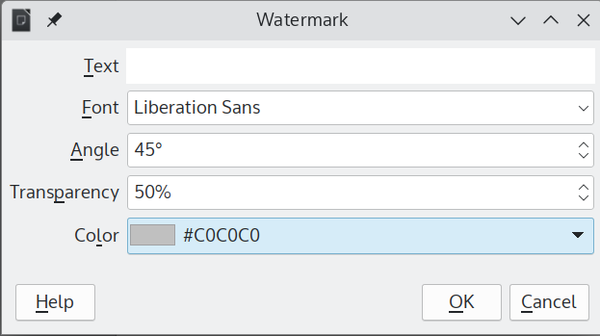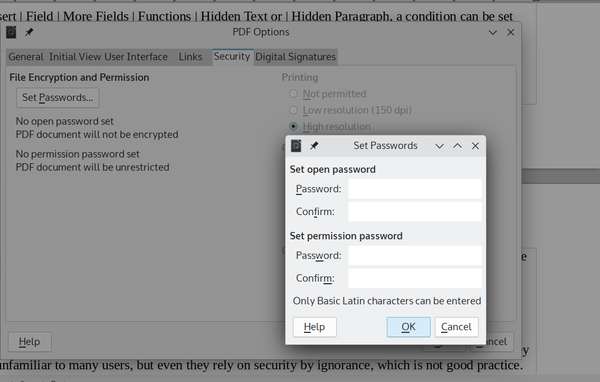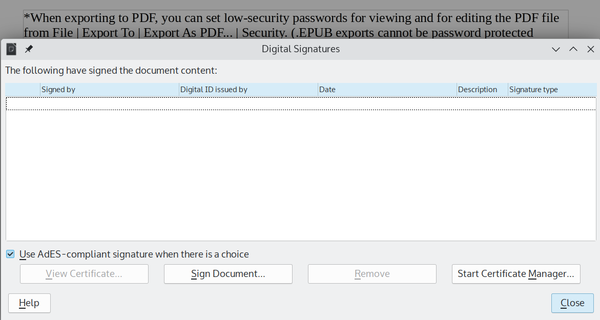Privacy and Security Tools in LibreOffice Writer
Protected Text

Image © Sergey Nivens, 123RF.com
Scattered in Writer’s menus are a surprising number of tools to keep your documents safe.
LibreOffice Writer does not have a privacy and security menu, so you might assume that it lacks such tools. The truth is, it has several of them, but they are scattered throughout the menus in a way that is easy to miss. Moreover, many can be implemented in more than one way and include different levels of protection. Most of these tools are for watermarks and passwords, but there are also tools for redaction, digital signatures, macros, and daily use.
Watermarks
Watermarks are words or images in the background of a page. They are often used on art images to discourage unwanted copying, although they are also used internally in organizations to clearly mark draft documents to avoid confusion and to trace the source of leaked documents. Do-it-yourself watermarks can be made using Writer’s Drawing toolbar and adjusting an image’s line and area so it becomes faint, or even invisible. Both are a popular way of either destroying a document’s usefulness in AI training or hiding proof of ownership that AI will copy unaware. Alternatively, a character or paragraph style’s color and transparency can be adjusted. If a text-only watermark is all that’s required, it can quickly be made and positioned via Format | Watermark (Figure 1). However the watermark is created, it can be placed on a page style to be used automatically. Placing it in a header or foot can make it especially inconspicuous.
Passwords
Writer can password-protect all or part of a document:
 Figure 2: Properties can set security for the document as a whole, but any portion of a document can have its own properties, using sections or fields.
Figure 2: Properties can set security for the document as a whole, but any portion of a document can have its own properties, using sections or fields.
- From File | Properties | Security, a document can be set read-only, or given a password. Note that a read-only file can still be copied (Figure 2).
- From Insert | Section, part of a document can be set read-only or given a password. This option can be useful on a copyright page where information about the document’s owner is printed.
- Insert | Field | More Fields | Functions | Hidden Text or | Hidden Paragraph, a condition can be set that must be used before a certain block of text displays. This condition is in effect a password, and could be used as a text watermark as well. Its main purpose is to maintain different versions of a document in a single file.
- When exporting to PDF, you can set low-security passwords for viewing and for editing the PDF file from File | Export To | Export As PDF... | Security. (EPUB exports cannot be password protected because they are an open standard). Permissions for different functions can be set, and digital signatures can also be used.
With all these settings, anything from a word to the entire document can be loosely protected. Given that Writer files are easy to search (like with Acrobat’s protection), these options should only be used to protect against non-hackers. The hidden fields are probably the most secure, because they are unfamiliar to many users, but even they rely on security by ignorance, which is not good practice. However, they are convenient and may be sufficient for many purposes.
Digital Certificates
Writer’s Digital Certificates options (in Files | Digital Certificates) are the most effective way to control access to a Writer file. Users might overlook this menu because digital certificates are often not free, but Writer’s use of the term “digital certificate” also includes PGP keys. This usage allows files to be conveniently encrypted from within Writer.
Buy Linux Magazine
Subscribe to our Linux Newsletters
Find Linux and Open Source Jobs
Subscribe to our ADMIN Newsletters
Support Our Work
Linux Magazine content is made possible with support from readers like you. Please consider contributing when you’ve found an article to be beneficial.

News
-
Parrot OS Switches to KDE Plasma Desktop
Yet another distro is making the move to the KDE Plasma desktop.
-
TUXEDO Announces Gemini 17
TUXEDO Computers has released the fourth generation of its Gemini laptop with plenty of updates.
-
Two New Distros Adopt Enlightenment
MX Moksha and AV Linux 25 join ranks with Bodhi Linux and embrace the Enlightenment desktop.
-
Solus Linux 4.8 Removes Python 2
Solus Linux 4.8 has been released with the latest Linux kernel, updated desktops, and a key removal.
-
Zorin OS 18 Hits over a Million Downloads
If you doubt Linux isn't gaining popularity, you only have to look at Zorin OS's download numbers.
-
TUXEDO Computers Scraps Snapdragon X1E-Based Laptop
Due to issues with a Snapdragon CPU, TUXEDO Computers has cancelled its plans to release a laptop based on this elite hardware.
-
Debian Unleashes Debian Libre Live
Debian Libre Live keeps your machine free of proprietary software.
-
Valve Announces Pending Release of Steam Machine
Shout it to the heavens: Steam Machine, powered by Linux, is set to arrive in 2026.
-
Happy Birthday, ADMIN Magazine!
ADMIN is celebrating its 15th anniversary with issue #90.
-
Another Linux Malware Discovered
Russian hackers use Hyper-V to hide malware within Linux virtual machines.




